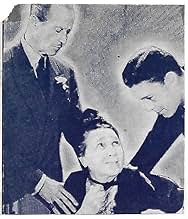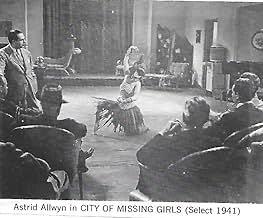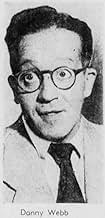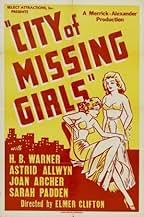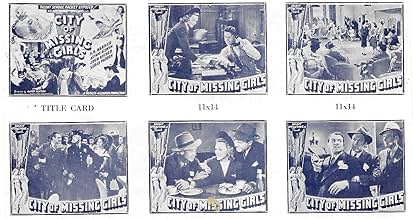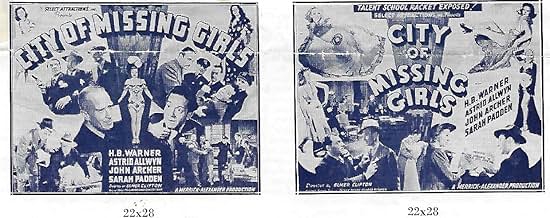Adicionar um enredo no seu idiomaThere's an epidemic of missing girls in the city. The new assistant district attorney has to figure out what's going on before he loses his job, especially with a nosy reporter making his li... Ler tudoThere's an epidemic of missing girls in the city. The new assistant district attorney has to figure out what's going on before he loses his job, especially with a nosy reporter making his life difficult.There's an epidemic of missing girls in the city. The new assistant district attorney has to figure out what's going on before he loses his job, especially with a nosy reporter making his life difficult.
- Direção
- Roteiristas
- Artistas
Kathryn Crawford
- Helen Whitney
- (as Katherine Crawford)
Gale Storm
- Mary Phillips
- (as Gail Storm)
Lassie Lou Ahern
- Nightclub Performer
- (não creditado)
Jack Chefe
- Apartment House Manager
- (não creditado)
Donald Curtis
- Reporter
- (não creditado)
Dorothy Granger
- Showgirl
- (não creditado)
Lloyd Ingraham
- District Attorney Fowler
- (não creditado)
Ralph Peters
- Reporter
- (não creditado)
- Direção
- Roteiristas
- Elenco e equipe completos
- Produção, bilheteria e muito mais no IMDbPro
Avaliações em destaque
"A string of mysterious deaths and disappearances of young women have all been traced to a drama school, where all the girls were students. The district attorney suspects the school may be a front for a prostitution ring and sets out to investigate it. After the D.A. is blackmailed into dropping the investigation, a female reporter decides to go undercover to learn the truth," according to the DVD sleeve's synopsis.
Writer/director Elmer Clifton manages to squeeze a few drops of blood from this stone. A scene between villain Philip Van Zandt (as King Peterson) asking "Do you mind if I smoke?" and hero John Archer (as Jimmy Horton) replying "I don't care if you burn" piques interest. Mr. Clifton and H.B. Warner (as "Mac" McVeigh) were bigger names during the silent film era (look for Walter Long, also).
Mr. Archer was a fine actor, who did not get the parts he deserved; and it shows, in this film. Teenage Gale Storm (as Mary Phillips), who unexpectedly became a 1950s TV and rock 'n' roll era recording star, is irresistibly cute; she, and brief pair of vivacious dancing girls, give the film some much-needed oomph. In spite of some strengths, "City of Missing Girls" remains oblique and recumbent.
**** City of Missing Girls (3/27/41) Elmer Clifton ~ John Archer, H.B. Warner, Gale Storm
Writer/director Elmer Clifton manages to squeeze a few drops of blood from this stone. A scene between villain Philip Van Zandt (as King Peterson) asking "Do you mind if I smoke?" and hero John Archer (as Jimmy Horton) replying "I don't care if you burn" piques interest. Mr. Clifton and H.B. Warner (as "Mac" McVeigh) were bigger names during the silent film era (look for Walter Long, also).
Mr. Archer was a fine actor, who did not get the parts he deserved; and it shows, in this film. Teenage Gale Storm (as Mary Phillips), who unexpectedly became a 1950s TV and rock 'n' roll era recording star, is irresistibly cute; she, and brief pair of vivacious dancing girls, give the film some much-needed oomph. In spite of some strengths, "City of Missing Girls" remains oblique and recumbent.
**** City of Missing Girls (3/27/41) Elmer Clifton ~ John Archer, H.B. Warner, Gale Storm
This is a very low budget B picture which is saved from being a waste of time by surprisingly good acting. The film is 98% shot in a studio with the most basic possible sets. The film did provide an opportunity for Gale Storm, aged 19, to appear in her third feature film (she started in movies only the year before). She would later become famous in America and become something of a 'national treasure' in the hit television series MY LITTLE MARGIE (1952-1955), in which she played Little Margie. Since the series ran to 126 episodes, there was no one in America who had not seen her and taken her to their hearts by the time that was over. And from 1956 to 1960 she continued to ride on her wave of national popularity with her own series, THE GALE STORM SHOW. This film featured H. B. Warner, a well-known and solid performer of the old school, as a police captain, and an extremely lively and cheerful Astrid Allwyn, who does a very good job at holding the film together and keeping us interested. She plays very well against John Archer, as there is chemistry in their jokey romance. The film is a mystery, in that several young girls from the city have disappeared, and no one can trace them. Two have been found dead, so that there is obviously something sinister going on. Whodunnit and who is doing it? That's what everyone wants to know. But it is not easy to find out. A rainy afternoon film.
An assistant DA tries to track the whereabouts of missing girls, leading into a tangled web of corruption.
With that suggestive title and sleaze director Elmer Clifton, I was expecting maximum titillation. Well, there is some peek-a-boo at The Crescent School of Fine Art, where the half-clad dancers somehow manage to all be female. No doubt, if it weren't for the censors, the "school" would be called Gateway to Hookerland, but then this is a commercial product.
Not surprisingly, it is a cheap undertaking by quick-buck producers. Still, the cast is much better than the material, especially the sparkly Allwyn and the smoothly slick Van Zandt, who's especially impressive as an egotistical gangster. His sarcastic exchanges with DA Horton (Archer) may well be the film's dramatic highlight. These main players may not be exactly household names but they do lend edge to what could have been merely a listless payday. Impressive too is old-timer HB Warner who's about as relaxed before the camera as anyone I've seen. Still, it's a long way from Jesus in King of Kings (1927), a silent screen classic. I imagine he was added for marquee value. Then too, catch malt-shop Gale Storm in a small but appealing part.
Anyway, it's a rather complex plot so you may need to keep notes. Still, the large cast does about as well with the tacky material as can be expected, and is not without points of interest.
With that suggestive title and sleaze director Elmer Clifton, I was expecting maximum titillation. Well, there is some peek-a-boo at The Crescent School of Fine Art, where the half-clad dancers somehow manage to all be female. No doubt, if it weren't for the censors, the "school" would be called Gateway to Hookerland, but then this is a commercial product.
Not surprisingly, it is a cheap undertaking by quick-buck producers. Still, the cast is much better than the material, especially the sparkly Allwyn and the smoothly slick Van Zandt, who's especially impressive as an egotistical gangster. His sarcastic exchanges with DA Horton (Archer) may well be the film's dramatic highlight. These main players may not be exactly household names but they do lend edge to what could have been merely a listless payday. Impressive too is old-timer HB Warner who's about as relaxed before the camera as anyone I've seen. Still, it's a long way from Jesus in King of Kings (1927), a silent screen classic. I imagine he was added for marquee value. Then too, catch malt-shop Gale Storm in a small but appealing part.
Anyway, it's a rather complex plot so you may need to keep notes. Still, the large cast does about as well with the tacky material as can be expected, and is not without points of interest.
Having seen H. B. Warner as a character player in dozens of films, i was pleasantly surprised to see him starring in this crime-exploitation film about the white slave trade. I was also deeply impressed with his ability to carry the complex role of a poetic, philosophical police captain on the verge of retirement with such presence during the course of what otherwise would seem to have been destined to be a routine crime drama.
Alas, being a post-code movie, the white slave trade aspect of the plot is only understandable as a subtext, but there are plenty of other intriguing moments in the movie that will make B-film enthusiasts sit up and say, "Wow." For me, the gymnastic dance featuring a pair of uncredited twin teen girls was one such moment. Where did they FIND such unusual talent? Who were those young, incredibly athletic, giggling twins? We'll probably never know.
And then there was the scene in which H. B. Warner, previously seeming to be frail, distracted, and ready for the scrap heap of life, suddenly LEAPED INTO THE AIR and jumped into his bed feet first! What the heck!? That was truly replay-worthy.
This is not a great film, of course, but since it is available at bargain prices, old film buffs will certainly get their money's worth if they take the time to seek it out and watch it.
Alas, being a post-code movie, the white slave trade aspect of the plot is only understandable as a subtext, but there are plenty of other intriguing moments in the movie that will make B-film enthusiasts sit up and say, "Wow." For me, the gymnastic dance featuring a pair of uncredited twin teen girls was one such moment. Where did they FIND such unusual talent? Who were those young, incredibly athletic, giggling twins? We'll probably never know.
And then there was the scene in which H. B. Warner, previously seeming to be frail, distracted, and ready for the scrap heap of life, suddenly LEAPED INTO THE AIR and jumped into his bed feet first! What the heck!? That was truly replay-worthy.
This is not a great film, of course, but since it is available at bargain prices, old film buffs will certainly get their money's worth if they take the time to seek it out and watch it.
This is the story of a crime boss who has a front for either white slavery or prostitution. The words are never spoken. This would have been pretty hot stuff for the time. It involves an assistant district attorney, a female reporter, and a cop who just can't retire. All in all, the chemistry is pretty good. The reporter isn't as tiresome as they usually are. She seems to have some soul and some merit. The bad guy is also pretty well conceived and presents a formidable presence. It is pretty formulaic but keeps our attention throughout. The blackmail thing is believable for the most part and the elements of the crime story are nicely balanced. The one thing that troubles me is the aftermath, dealing with the reporter's father. I won't give anything away, so see what you think of the ending scene.
Você sabia?
- CuriosidadesThis film received its earliest documented telecast Saturday 5 August 1944 on New York City's pioneer television station WNBT (Channel 1). Post-WWII television viewers got their first look at on the East Coast Wednesday 29 December 1948 on WATV (Channel 13) (New York City), and on the West Coast Wednesday 4 May 1949 on KPIX (Channel 5) (San Francisco).
- Citações
King Peterson: Do you mind if I smoke?
Assistant D.A. James J. Horton: I don't care if you burn.
- ConexõesReferenced in Assassino a Preço Fixo (1972)
Principais escolhas
Faça login para avaliar e ver a lista de recomendações personalizadas
Detalhes
- Tempo de duração1 hora 14 minutos
- Cor
- Mixagem de som
- Proporção
- 1.37 : 1
Contribua para esta página
Sugerir uma alteração ou adicionar conteúdo ausente

Principal brecha
By what name was City of Missing Girls (1941) officially released in Canada in English?
Responda
